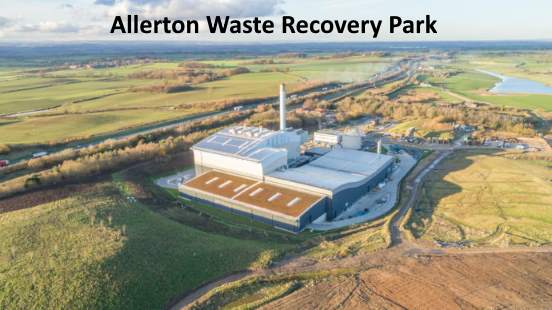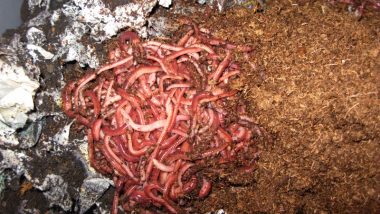 Allerton Waste Recovery Park, is a waste management facility for North Yorkshire and the City of York which was commissioned in early 2018. The Allerton Waste Recovery Park accepts municipal and commercial waste and includes a materials recovery facility, a 24MWe EfW plant (incinerator) handling 320,000 tonnes per year of waste and a 1.1MWe biogas plant.
Allerton Waste Recovery Park, is a waste management facility for North Yorkshire and the City of York which was commissioned in early 2018. The Allerton Waste Recovery Park accepts municipal and commercial waste and includes a materials recovery facility, a 24MWe EfW plant (incinerator) handling 320,000 tonnes per year of waste and a 1.1MWe biogas plant.
It has a 70-metre high steel stack which discharges the off-gas from the incinerator, which is mostly water vapour and carbon dioxide.
Vinci Environment UK were responsible for construction and Taylor Woodrow provided civil engineering works.
Defining the Meaning of a “Waste Recovery Park”
A waste recovery park is a materials recovery facility or MRF.
Allerton Waste Recovery Park Declared Fully Operational
Allerton Waste Recovery Park will transform an annual 320,000 tonnes of waste from households in North Yorkshire and York into enough power for at least 40,000 homes, but potentially as many as 60,000 homes, based on Ofgem’s most recent figures for a typical UK household’s usage.
It will also reduce landfill and increase recycling.
The three-year build programme by Amey reached its final construction milestone on 1 March 2018 when it formally moved into its 25-year operational phase following a period of rigorous independent commissioning and testing.
Allerton Waste Recovery Park is unique in the UK for combining three state-of-the-art technologies on one site – mechanical treatment, anaerobic digestion and energy from waste (EfW).
Allerton Waste Recovery Park can deal with up to 1,400 tonnes of waste per day. First, the waste passes through mechanical treatment where machinery separates the recyclable, food and biodegradable material. Recyclates can be reprocessed into new products while biodegradable materials pass to the anaerobic digestion plant for conversion into electricity.
The remaining waste is burned in the energy from waste facility to create electricity. Comprehensive filter systems capture and control emissions and even the resulting ash is suitable for re-processing once metals have been removed for recycling. Every year, the EfW will generate around 74,000 tonnes of ash which will be turned into construction-related materials for use on highways and infrastructure projects.
Anaerobic digestion and EfW treatment will together generate around 218GWh electricity per year. Some of this is used to power the facility itself but the plant will also export enough electricity to support a town up to one and a half times the size of Harrogate.
Early signs suggest the turbine is working efficiently and has already started exporting electricity above the designed 24MW per hour onto the national grid.
The above text is based on a post CIWM Business Partner News Round-Up which appeared first on CIWM Journal Online.
How the Allerton Waste Recovery Facility Was Funded and Set-up
Before the UK Green Investment bank was sold-off by the UK government in 2017 it funded UK Green Investment Bank (GIB). The bank is believed to have invested £33 million in the Allerton Waste Recovery Park in North Yorkshire, despite government pulling private finance initiative (PFI) funding from the project last year.
The project opeates uder a public-private partnership (PPP) between North Yorkshire County Council and City of York Council alongside sponsors AmeyCespa, Aberdeen UK Infrastructure Partners (a fund managed by Aberdeen Asset Management) and Equitix. Through this fusning it will receive long-term loan financing and an equity bridge loan.
The money is being provided by GIB alongside investment from Nord/LB, Sumitomo Mitsui Banking Corporation, Siemens Bank, KfW-IPEX and the European Investment Bank (EIB). This is the first joint-investment between GIB and EIB.
Allerton Waste Treatment Plant Details
Set for development in an existing landfill and quarry site in Allerton, the project is designed to process up to 320,000 tonnes of household, commercial and industrial waste per year.
This will include all of the residual waste from North Yorkshire County Council and the City of York, with the remaining capacity of the plant used to process commercial and industrial waste sourced by AmeyCespa.
The technologies utilised by the park will be:
- mechanical treatment, which will screen out organic matter and recover metal, paper and plastic for recycling;
- anaerobic digestion (AD), which will break down the separated organic waste into biogas, which will be used to generate around 1.1 megawatts (MW) of renewable power;
- incineration, which will heat the remaining waste to produce steam to feed an electricity generating turbine that will generate around 24MW of power. Spare heat produced by the process could be supplied to local external customers if a market can be established; and
- incinerator bottom ash (IBA) recovery, which will process residual material from the incineration plant into an aggregate that can be used in construction.
If the UK government is to achieve the “Zero-waste” promise made by PM David Cameron, it will need to finance and build many more waste processing plants similar to this one. Zero-waste should be assumed to mean, a target of ceasing to send any waste to landfill. It does not mean that no waste will be generated at all, although the public may well think that it means just that!





On the heels of a discussion concerning recycling some unopened meals are thrown in the bin, What would certainly occur if we simply tossed these platefuls out the window? Youw ould not do that would you? Responsibly recycling things is a great way to maximize resources. When people think of green energy they think of alternative energy. However, it is just as important to get the most from the non-renewable resources that we use as it is to minimize our use. Recycling electronics prevents unnecessary polluting of landfills as well as reuses resources that non-renewable.
On the heels of a conversation about reusing some broken dishes to make a birdbath, I said, “Hey lets see if we can find a website to show you what would happen if we just threw these plates out instead.” This was perfect! My 5 year old says, “We really love your page/ video. Thank you!”?
I did not like slow videos your video is best and very innovative.
Thanks for making the principle of waste recycling as well as reusing so easily accessible to little us uneducated ones.
Bravo?
Awesome writing and entertaining to read.
My passion for the environment is similar to yours. At Allerton let’s hope they can keep some of the plastic out of our oceans by what they are doing?.